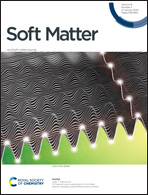Protonation-induced pH increase at the triblock copolymer micelle interface for transient membrane permeability at neutral pH†
Abstract
Achieving controlled membrane permeability using pH-responsive block copolymers is crucial for selective intercellular uptake. We have shown that the pH at the triblock-copolymer micelle interface as compared to its bulk pH can help regulate membrane permeability. The pH-dependent acid/base equilibriums of two different interface-interacting pH probes were determined in order to measure the interfacial pH for a pH-responsive triblock copolymer (TBP) micelle under a wide range of bulk pH (4.5–9.0). According to 1H NMR studies, both pH probes provided interfacial pH at a similar interfacial depth. We revealed that the protonation of the amine moiety at the micelle interface and the subsequent formation of a positive charge caused the interface to become relatively less acidic than that of the bulk as well as an increase in the bulk-to-interfacial pH deviation (ΔpH) from ∼0.9 to 1.9 with bulk pH reducing from 8.0 to 4.5. From the ΔpH vs. interface and bulk pH plots, the apparent and intrinsic protonations or positive charge formation pKa values for the micelle were estimated to be ∼7.3 and 6.0, respectively. When the TBP micelle interacted with an anionic large unilamellar vesicle (LUV) of a binary lipid (neutral and anionic) system at the bulk pH of 7.0, fluorescence leakage studies revealed that the pH increase at the micelle interface from that of the LUV interface (pH ∼ 5.5) made the micelle interface partially protonated/cationic, thereby exhibiting transient membrane permeability. Although the increasing interface protonation causes the interface to become relatively less acidic than the bulk at any bulk pH below 6.5, the pH increase at the micelle interface may not be sufficiently large to maintain the threshold for the amine-protonated condition for effecting transient leakage and therefore, a continuous leakage was observed due to the slow disruption of the lipid bilayer.



 Please wait while we load your content...
Please wait while we load your content...